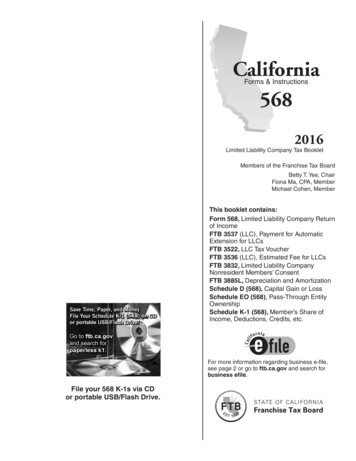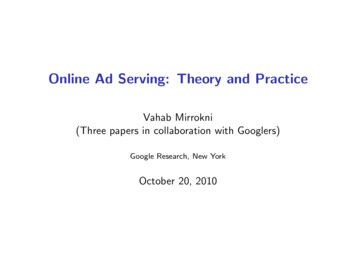
Transcription
ADS Chapter 568National Security Information ProgramPartial Revision Date: 06/15/2022Responsible Office: SEC/CTISFile Name: 568 061522
06/15/2022 Partial RevisionFunctional Series 500 - Management Services Chapter 568 - National SecurityInformation ProgramPOC for ADS 568: Diane Sloan, dsloan@usaid.govTable of Contents568.1OVERVIEW . 4568.2PRIMARY RESPONSIBILITIES . 4568.3POLICY DIRECTIVES AND REQUIRED PROCEDURES . lassification of National Security Information . 5Classified Information Levels. 5Original Classification Authority . 6Classification Challenges . 8Classification Guide. 9Fundamental Classification Guidance Review (FCGR) . 9Annual Summary Preparation, SF-311 Report . 10Identification and Marking . 10Classification Prohibitions and Limitations . 11SEC Review . 12FOIA Review . 12568.3.2568.3.2.1568.3.2.2Access, Control, and Dissemination . 13Designated Restricted and Unrestricted Spaces . 14Sensitive Compartmented Information (SCI) . 568.3.3.11568.3.3.12568.3.3.13Storage and Safeguarding of Classified Materials . 15Storage of Classified Materials . 15Security Container Combinations . 16Procedures for Removing or Moving a Security Container (Safe) . 17Security Container (Safe) Procurement . 17Procedures for Safeguarding Classified Materials. 18Closing Hours Security Check . 18Envelopes and Cover sheets. 20Meetings and Conferences. 21Transporting or Transmitting Classified Materials Within USAID OfficeSpaces . 22Hand-Carrying Classified Information. 23Outside of USAID Office Areas . 25Reproduction of Classified Material . 26Destruction Procedures . 27568.3.4568.3.4.1568.3.4.2Security Education and Awareness . 27General Requirements . 27Initial Security Training . 282
06/15/2022 Partial 4.7568.3.4.8568.3.4.9568.3.4.10Annual Security Refresher Training. 29Original Classification Authority (OCA) Training . 30Derivative Classification Authority Training . 31Unit Security Officer (USO) Training . 31Special Access . 31Termination Briefings (Debriefings) . 31Separation Overseas. 32Security Inspections . ity Incident Program . 34Reporting Security Incidents. 34Examples of Security Incidents . 35Categorization of Security Incidents . 36Disciplinary Actions and Security Clearance Review Related to PDS andSecurity Infractions . 37Disciplinary Actions and Security Clearance Review Related toSecurity Violations . 38Appeals of Security Incidents . 38568.3.5.5568.3.5.6568.3.6Processing Classified National Security Information on USAIDAutomated Systems . 39568.3.7Counterintelligence . .8.5568.3.8.6Portable Electronic Devices (PEDs) . 39Policy and Procedures . 39Storage Outside of Restricted Spaces . 41Classified Portable Electronic Devices . 41Medical Devices . 42Emergency Personnel . 42Compliance and Disciplinary Action . 42568.4MANDATORY REFERENCES . 43568.4.1External Mandatory References . 43568.4.2Internal Mandatory References . 45568.4.3Mandatory Forms . 45568.5ADDITIONAL HELP . 46568.6DEFINITIONS. 463
06/15/2022 Partial RevisionChapter 568 - National Security Information Program568.1OVERVIEWEffective Date: 05/19/2017This ADS chapter provides the policy directives and required procedures for USAID’simplementation of the Information Security Program, which includes classification ofnational security information, the storage and safeguarding of classified information,security education and awareness, the security incident program, as well as access,control, and dissemination.The Executive Order (EO) 13526, Classified National Security Information; EO12968, Access to Classified Information; EO 13467 Roles and Responsibilities ofthe National Background Investigations Bureau and Related Matters; EO 12829,National Industrial Security Program; National Industrial Security ProgramOperating Manual (NISPOM); and 12 FAM 500, Information Security.Throughout this chapter, the term "workforce" or “members of the workforce” refers toindividuals working for, or on behalf of, the Agency, regardless of hiring or contractingmechanism, whose job involves physical and/or logical access to USAID. This mayinclude Direct-Hire employees, Personal Services Contractors, Participating AgencyService Agreement (PASAs) and contractor personnel. Contractors are not normallysubject to Agency policy and procedures as discussed in ADS 501.1. However, contractorpersonnel are included here by virtue of the applicable clauses in the contract related toHSPD-12 and Information Security requirements.568.2PRIMARY RESPONSIBILITIESEffective Date: 05/19/2017a.The Administrator (A/AID) has the authority to originally classify information andis responsible for ensuring that designated subordinate officials have a demonstrable andcontinuing need to exercise this authority.b.The USAID Director of Security (D/SEC) is the USAID senior Agency officialunder Executive Orders (EOs) 13526, 12968, and 13467. The responsibilities of thesenior Agency official are stipulated in each of the EOs (see EO 13526, EO 12968, EO13467 and EO 12829).c.The Office of Security, Chief, Counterterrorism Information SecurityDivision (SEC/CTIS) is responsible for overseeing and implementing program policiesand responsibilities related to the Information and Industrial Security (IIS) program. TheChief, CTIS maintains oversight of all USAID Sensitive Compartmented InformationFacilities (SCIFs).d.The Executive Secretariat (ES) of the Agency, who retains special securityrepresentatives (SSRs) working under the direction of the Office of Security (SEC)Special Security Officer (SSO), is responsible for the day-to-day management of theSixth Floor Sensitive Compartmented Information Facility.4
06/15/2022 Partial Revisione.The Bureau for Management, Office of Management Services, Informationand Records Division (M/MS/IRD) is responsible for administering the USAID programfor systematic and mandatory declassification reviews of classified documents. Theseresponsibilities include data collection and statistical analysis reporting and preparationof reports requested by the Information Security Oversight Office (ISOO).f.The Unit Security Officer (USO) is responsible for ensuring that all operationswithin his or her respective Mission or Bureau/Independent Offices (B/IO) are carriedout in accordance with the security regulations in this ADS chapter. This responsibilityis generally delegated to the Executive Officer (EXO).g.The Administrative Management Specialist (AMS) in each B/IO is responsiblefor coordination and documentation of classification activity, end-of-day security checks,training, and corrective actions related to security incidents or findings.h.The Original Classification Authority (OCA) is responsible for the annualreview of the USAID Classification Guide and the proper conduct and documentation ofclassification decisions.i.The Office of Human Capital and Talent Management, Employee LaborRelations (HCTM/ELR) is responsible for coordinating with SEC for formal disciplinaryactions for non-compliance with policies.568.3568.3.1POLICY DIRECTIVES AND REQUIRED PROCEDURESClassification of National Security InformationEffective Date: 05/19/201712 FAM 500 contains the policy and procedures for USAID and all foreign affairs agenciesconcerning the implementation of EO 13526. The policies and required procedures in thisADS chapter supplement 12 FAM 500 for USAID and must be considered in conjunctionwith 12 FAM 500 and EO 13526.The head of each Bureau/Independent Office (B/IO) and overseas USAID Mission mustappoint a Unit Security Officer (USO). Individuals with original classification authority;security managers or security specialists; and employees whose duties significantlyinvolve the creation or handling of classified information, including employees whoregularly apply derivative classification markings, will be evaluated for this activity duringthe annual performance period. This requirement also applies to USAID employeesincluding, but not limited to, Executive Officers (EXOs), Administrative ManagementSpecialists (AMSs), USOs, and employees within the Administrator’s office (A/AID), theExecutive Secretariat (ES), and the Office of Security (SEC). The evaluation will assesstheir ability to designate and manage classified information and will be considered acritical element in the AEFs for all employees.568.3.1.1Classified Information LevelsEffective Date: 05/19/20175
06/15/2022 Partial RevisionInformation is deemed classified when it is determined that the unauthorized disclosure ofthat information could cause some degree of damage to national security. Informationmay be classified at one of the following levels (see EO 13526): Confidential: must be applied to information, the unauthorized disclosure of whichreasonably could be expected to cause damage to the national security that theoriginal classification authority is able to identify or describe. Secret: must be applied to information, the unauthorized disclosure of whichreasonably could be expected to cause serious damage to the national securitythat the original classification authority is able to identify or describe. Top Secret: must be applied to information, the unauthorized disclosure of whichreasonably could be expected to cause exceptionally grave damage to the nationalsecurity that the original classification authority is able to identify or describe.Except as otherwise provided by statute, no other terms will be used to identify UnitedStates classified information.If there is significant doubt about the appropriate level of classification, the authorizedcreator of the information must classify it at the lower level.568.3.1.2Original Classification AuthorityEffective Date: 05/19/2017"Original classification" means an initial determination that information requires, in theinterest of the national security, protection against unauthorized disclosure.Information may be originally classified under the terms of EO 13526 only if all of thefollowing conditions are met: An original classification authority is classifying the information; The information is owned by, produced by or for, or is under the control of theUnited States Government; The information falls within one or more of the categories of information listed insection 1.4 of EO 13526; andThe original classification authority determines that the unauthorized disclosure of theinformation reasonably could be expected to result in damage to national security, whichincludes defense against transnational terrorism, and the original classification authority isable to identify or describe the damage. The unauthorized disclosure of foreigngovernment information is presumed to cause damage to national security.6
06/15/2022 Partial RevisionIf the OCA has significant doubt about the need to classify information, it must not beclassified.Classified information will not be declassified automatically as a result of anyunauthorized disclosure of identical or similar information.As prescribed in EO 13526, the authority to classify information originally may beexercised only by the President, agency heads, officials designated by the President inthe Federal Register, or other United States Government officials delegated this authority.Officials authorized to classify information at a specified level are also authorized toclassify information at a lower level.Delegation of original classification authority must be limited to the minimum required toadminister this order. Agency heads are responsible for ensuring that designatedsubordinate officials have a demonstrable and continuing need to exercise this authority.Each delegation of original classification authority must be in writing and the authoritymust not be re-delegated except as provided in this order.The number of USAID officials possessing original classification authority as outlined inEO 13526 is strictly limited. USAID officials do not have the authority to classify at the TopSecret (TS) or Sensitive Compartmented Information (SCI) level. As the Agency head, theAdministrator (A/AID) has the authority to originally classify information at the Confidentialand Secret level. Authority to originally classify at the Confidential and Secret level hasbeen delegated by the Administrator to the following positions: Deputy Administrator (DA/AID), Inspector General (IG), and Director of Security (D/SEC).In order to ensure the appropriateness of classifications, the respective AMS officials orspecial assistants for A/AID, DA/AID, D/SEC and IG must report the following informationto SEC/CTIS/IIS no later than September 30 each year: All original classification decisions made by their respective Original ClassificationAuthority (OCA) to include the classification level, Document type, Reason for classification, The OCA’s name, Declassification date, and The date on which the document was classified.7
06/15/2022 Partial RevisionIf a member of the workforce has or believes they have information that should beoriginally classified, they must contact an OCA or reference a classification guide forfurther guidance. USAID employees within the continental U.S. should contact one of theOCAs listed above or reference USAID’s Classification Guide (see 568.3.1.4). The USAIDworkforce overseas should contact the Regional Security Officer or reference USAID’sClassification Guide.[Note: All members of the workforce with a valid security clearance and who complete themandatory annual security refresher training possess derivative classification authority.These individuals may derivatively classify information in hard copy and electronic form.EO 13526 states “persons who only reproduce, extract, or summarize classifiedinformation, or who only apply classification markings derived from source material or asdirected by a classification guide, need not possess original classification authority.” EO13526, section 2.1 and the Information Security Oversight Office’s booklet entitledMarking Classified National Security Information (December 2010, Revision 3,August 2016) outline the procedures for exercising derivative classification and markingof documents.]568.3.1.3Classification ChallengesEffective Date: 05/19/2017As per EO 13526, section 1.8, authorized holders of information who, in good faith,believe that its classification status is improper are encouraged and expected to challengethe classification status of the information. If holders or recipients of classified informationhave substantial reason to believe that the information is improperly classified, they mustcommunicate that belief to the classifier of the information. Individuals are not subject toretribution for bringing such actions. The classification authority block will identify theclassifier of the information on the classified document as indicated in 568.3.1.7Members of the workforce challenging a classification must sufficiently describe theinformation being challenged to permit identification of the information and its classifier.Individuals challenging a classification must also include the reason(s) why the challengerbelieves that the information is classified improperly or unnecessarily.These individuals may direct classification challenges, allegations, or complaintsregarding over-classification or incorrect classification within the Agency in writing orelectronically through the secure classified computer systems to an OCA. Individuals areprovided with the opportunity for their challenge to be reviewed by an impartial official orpanel. Individuals accessing the classified computer systems must have a securityclearance, attend a mandatory training on how to properly use the system, and sign theappropriate user agreement.OCAs receiving challenges pursuant to this section must provide a response within 30calendar days of the confirmed receipt of the challenge. The OCA must notify thechallenger of any changes made as a result of the challenge or the reasons why nochange was made. Pending final determination of a challenge to classification, OCAs8
06/15/2022 Partial Revisionmust safeguard the information or document in question as required for the level ofclassification initially assigned.If not resolved by the OCA, the challenger may appeal the decision to SEC/CTIS.SEC/CTIS must provide a response within 30 calendar days of the confirmed receipt ofthe appeal. If resolution cannot be obtained within the Agency, further appeal may bemade to the Interagency Security Classification Appeals Panel (ISCAP). The timeframe inwhich ISCAP will respond to appeals is solely determined by ISCAP. Documents requiredto be submitted for prepublication review or other administrative process pursuant to anapproved non-disclosure agreement are not covered by EO 13526, section 1.8.568.3.1.4Classification GuideEffective Date: 05/19/2017The USAID workforce can use USAID’s Classification Guide to derivatively classifyinformation. As per EO 13526 and 32 CFR Parts 2001 and 2003, an individual isdetermined to have derivative classification authority if they have the appropriate securityclearance and have completed derivative classification training every year.USAID’s Classification Guide may be used by those who have derivative classificationauthority to assist in avoiding over-classification. It is imperative that classified informationis properly marked and classified at the appropriate level to protect national security.USAID’s Classification Guide is classified and available through the secure classifiedcomputer systems.568.3.1.5Fundamental Classification Guidance Review (FCGR)Effective Date: 05/19/2017As per EO 13526 and 32 CFR Parts 2001 and 2003, SEC must complete, on a periodicbasis, a comprehensive review of the Agency's classification guidance, particularlyclassification guides, to ensure the guidance reflects current circumstances and to identifyclassified information that no longer requires protection and can be declassified.As per 32 CFR Part 2001, USAID will conduct a fundamental classification guidancereview at least once every five years. 32 CFR Part 2001.16 explains the items that shouldbe focused on throughout the review. A detailed report summarizing the results of eachclassification guidance review is provided by the IIS Branch to the Information SecurityOversight Office (ISOO).The classification guidance review includes an evaluation of classified information todetermine if it meets the standards for classification under section 1.4 of EO 13526, takinginto account an up-to-date assessment of likely damage as described under section 1.2 ofEO 13526. The goal of the Fundamental Classification Guidance Review (FCGR) is toensure agency classification guidance authorizes classification only in those specificinstances necessary to protect national security. ISOO provides guidance on completingthe FCGR to the Senior Agency Official.The classification guidance review includes original classification authorities and agency9
06/15/2022 Partial Revisionsubject matter experts to ensure a broad range of perspectives. The head of each B/IOand the OCA must conduct an annual review of the USAID Classification Guide (a copy ofthe Guide may be obtained by contacting SEC/CTIS/IIS atsecinformationsecurity@usaid.gov) and submit any recommended changes in writingto SEC/CTIS. The designated B/IO reviewer or OCA may recommend the addition ofspecific types of information to be classified or the modification of specific portions of theGuide, as applicable, to meet the program requirements of their respective B/IO.SEC reports its classification guidance reviews to the Director of the Information SecurityOversight Office (ISOO).568.3.1.6Annual Summary Preparation, SF-311 ReportEffective Date: 05/19/2017The Bureau for Management, Office of Management Services, Information and RecordsDivision (M/MS/IRD) will prepare an annual summary of all documents reviewed anddeclassified during the fiscal year. M/MS/IRD must provide the summary to the Office ofSecurity (SEC) at the conclusion of each fiscal year for inclusion in the Agency's annualreport to the ISOO. This report is due to ISOO by November of each year.SEC will coordinate and collaborate with the AMS/USO in B/IOs, as appropriate, to collecta representative sample of classification actions (derivative and original) performed byauthorized classifiers based upon ISOO guidance and methodologies for the SF-311,Agency Security Classification Management Program Data form.SEC hosts an annual face-to-face SF-311 sampling training for AMS/USOs. Each B/IOmust send a representative to participate in the training. The AMS/USO representativemust communicate the information provided in the training to the entire B/IO. In thetraining, the AMS/USO will be provided with the SF-311, Survey Sheet and receivetraining on how to properly fill it out and submit to SEC. AMS/USOs will also receivetraining on the sampling methodology, approved by ISOO, to arrive at the totalclassification decision numbers for the entire year. SEC will determine the samplingpopulation and sampling period and communicate this to the AMS/USO at this training.Members of the workforce must provide their AMS/USO with their classification numbersso the AMS/USO can complete and submit the SF-311, Survey Sheet to SEC no laterthan October 15 or by the date provided at the sampling training (whichever occurs firstfor that calendar year), each year for inclusion in the Agency’s annual report to the ISOO.Individuals must also report negative responses (i.e. if an individual has no classificationdecisions). For questions on this report and its requirements, contact the IIS branch atsecinformationsecurity@usaid.gov.See ISOO’s Web site, https://www.archives.gov/isoo template, for the SF-311 templateand FAQs.568.3.1.7Identification and MarkingEffective Date: 05/19/201710
06/15/2022 Partial RevisionAll members of the workforce must identify and mark all classified material as provided insection 1.6 of EO 13526. Paper document markings must not deviate from the formatprescribed in EO 13526 and the Information Security Oversight Office’s booklet entitledMarking Classified National Security Information (December 2010, Revision 3,August 2016). This booklet addresses various topics related to markings, including butnot limited to: Original and derivative classification decisions, Additional or special markings, Foreign government information, Declassification instructions, Portion markings, The identity of the classification authority and office of origin, and The date or event for declassification.568.3.1.8Classification Prohibitions and LimitationsEffective Date: 05/19/2017In no case will information be classified, maintained as classified, or fail to be declassifiedin order to: Conceal violations of law, inefficiency, or administrative error; Prevent embarrassment to a person, organization, or agency; Restrain competition; or Prevent or delay the release of information that does not require protection in theinterest of the national security.Basic scientific research information not clearly related to the national security should notbe classified. Information may not be reclassified after declassification and then releasedto the public under proper authority unless: The reclassification is personally approved in writing by the agency head based ona document-by-document determination by the agency that reclassification isrequired to prevent significant and demonstrable damage to the national security; The information may be reasonably recovered without bringing undue attention tothe information;11
06/15/2022 Partial Revision The reclassification action is reported promptly to the Assistant to the President forNational Security Affairs (National Security Advisor) and the Director of theInformation Security Oversight Office; and For documents in the physical and legal custody of the National Archives andRecords Administration (National Archives) that have been available for public use,the agency head has, after making the determinations required by this paragraph,notified the Archivist of the United States (Archivist), who must suspend publicaccess pending approval of the reclassification action by the Director of theInformation Security Oversight Office. Any such decision by the Director may beappealed by the agency head to the President through the National SecurityAdvisor. Public access must remain suspended pending a prompt decision on theappeal.Information that has not previously been disclosed to the public under proper authoritymay be classified or reclassified after an agency has received a request for it under theFreedom of Information Act (5 USC 552), the Presidential Records Act, 44 USC2204(c)(1), the Privacy Act of 1974 (5 USC 552a), or the mandatory review provisions ofsection 3.5 of Executive Order 13526 (only if such classification meets the requirements ofthis order and is accomplished on a document-by-document basis with the personalparticipation or under the direction of the Agency head, the Deputy Agency head, orD/SEC). The requirements in this paragraph also apply to those situations in whichinformation has been declassified in accordance with a specific date or event determinedby an original classification authority in accordance with section 1.5 of EO 13526.Compilations of items of information that are individually unclassified may be classified ifthe compiled information reveals an addi
National Industrial Security Program; National Industrial Security Program Operating Manual (NISPOM); and 12 FAM 500, Information Security. Throughout this chapter, the term "workforce" or "members of the workforce" refers to individuals working for, or on behalf of, the Agency, regardless of hiring or contracting











